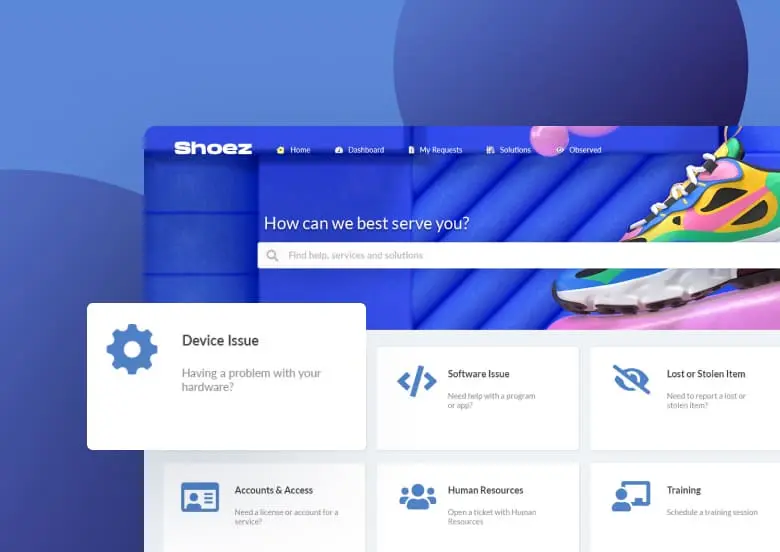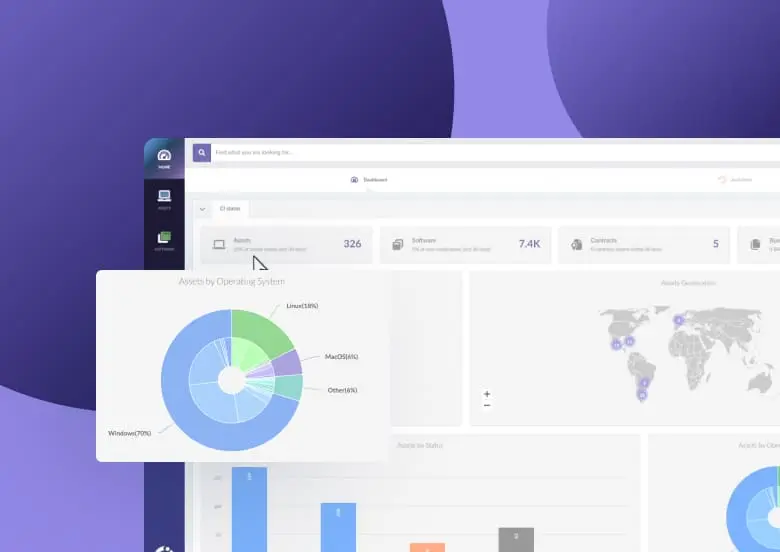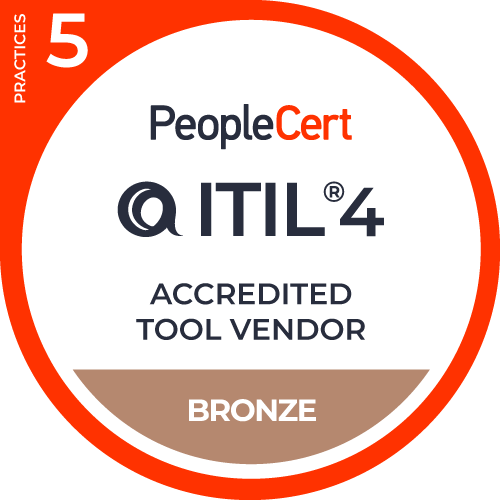IT Operations or ITOps have long been a key part of IT Service Management (ITSM) for organizations. It has played and continues to play an important role in maintaining organizations’ IT infrastructure up and running and making IT available to all employees.
Unlike the service desk which directly communicates with the employees, the activities of ITOps rarely involve direct contact with the users they serve. While the duties and responsibilities of IT operations are clearly defined in ITIL, it often varies with organizations. And there’s often overlap between other elements of ITSM.
Let’s explore what ITOps are, and what are the roles and responsibilities involved here.
What is IT Operations (ITOps)?
According to Gartner, ITOps is “the people and management processes associated with IT service management to deliver the right set of services at the right quality and competitive costs for customers.”
ITOps is one of the core functions of ITSM, the other three being application management, service desk, and technical management. The service desk deals with the queries from employees and customers, application management is involved with designing and developing applications, and technical management is related to providing technical expertise regarding the organization’s IT infrastructure.
IT Operations is entrusted with maintaining routine tasks and other activities that maintain the infrastructure for other services. This includes maintaining and updating the networking and computing hardware to ensure that the servers have proper air-conditioning and that they don’t overheat.
While there may be some overlaps with other functions, the general role of IT Operations is to keep the organization’s hardware functioning as designed and ensure that they support the other functions as well as the business processes of the organization.
What are the processes and responsibilities involved in IT Operations?
There are 4 major processes involved in IT operations. They are:
Mitigating disasters: IT operations plays a key role in the organization's disaster recovery and business continuity plans. They plan, simulate, and try to predict the impact of a disaster event and try to mitigate its effects on the company. In the event of a disaster, ITOps is responsible for resetting the hardware and software configurations at the earliest and costing the least.
Running solutions: This involves preparing the backups, preparing the servers, and managing the IT resources to ensure that the service delivery is up to the mark. ITOps optimize the servers and other hardware to get the maximum efficiency and ensure they’re available as necessary to the different services.
Maintain and manage IT infrastructure: This involves maintaining the hardware and software that keeps the IT infrastructure running. ITOps is responsible for setting up the hardware and maintaining the facilities that house them. The responsibilities also include managing the hybrid cloud and the applications deployed on the cloud. They’re also responsible for configuring the different components and documenting them.
Evolution of IT infrastructure: Implementing the latest technology and practices to improve the efficiency of the IT infrastructure is an ITOps responsibility. They’re in charge of upgrading the software and hardware for the organization’s IT to function without a glitch.
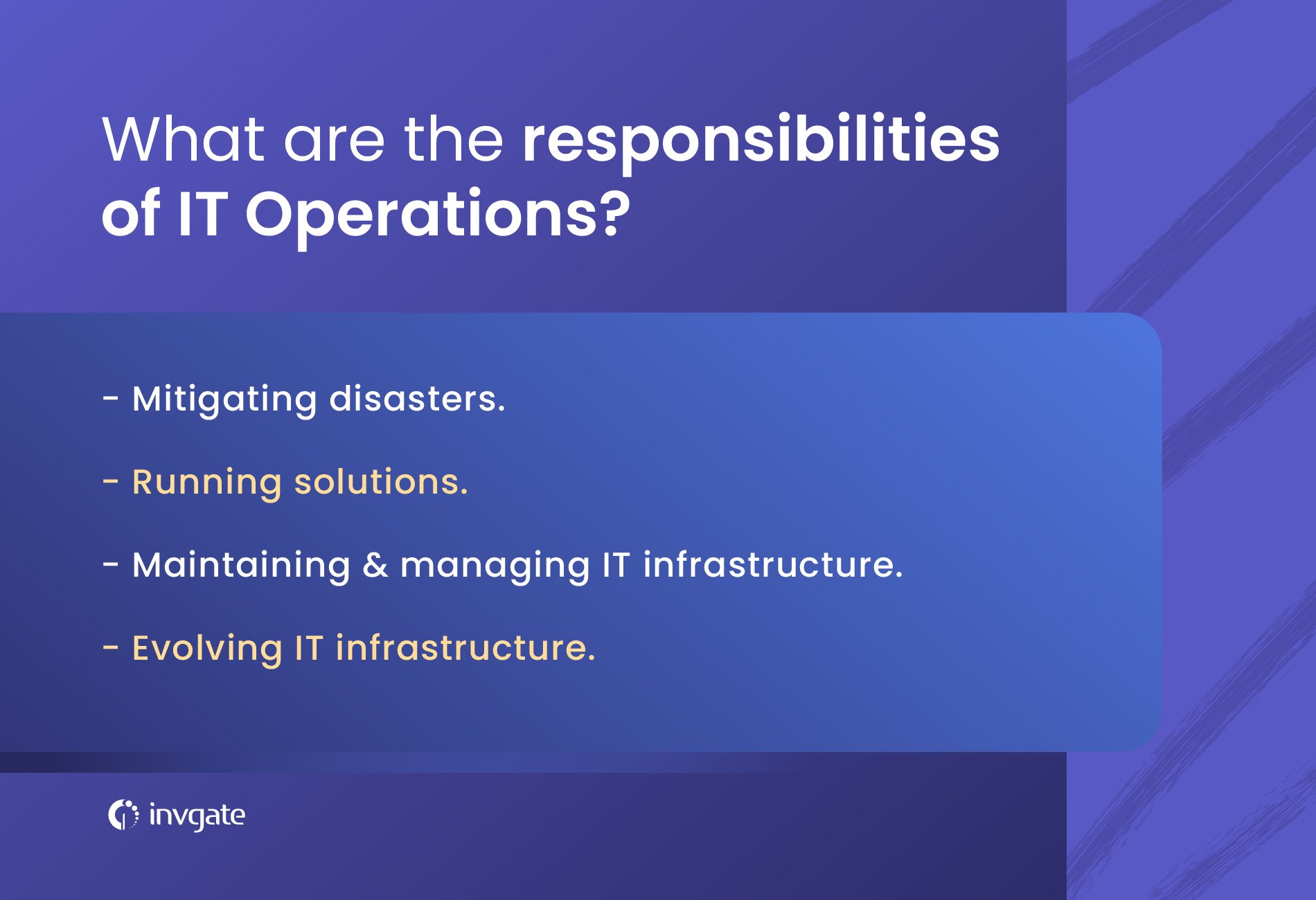
The IT Operations Management (ITOM) responsibilities are divided into four.
Infrastructure Management: As the name suggests this involves designing the network architecture, updating the software systems and the operating system, and maintaining the physical servers as well as the network infrastructure.
Development Management: Here the ITOps team works closely with DevOps to set the requirements, goals, and specifications for developing applications for the organization. Along with DevOps, they ensure that the applications are secure, satisfy performance standards, and are stable and robust for the operational use-cases.
Problem Management: This involves both preventative and reactive measures. ITOps is responsible for anticipating any incidents or events associated with any changes and preparing the IT services to mitigate their effect. They’re also responsible for reacting to any sudden outages or cyberattacks and implementing disaster recovery and business continuity plans.
Security management: In all of the above functions and responsibilities, ITOps have to include strong security practices. For example, while developing applications, ITOps have to specify the standards for security, and during facility management, they’re responsible for ensuring robust access management protocols.
What are the functions of IT operations?
The functions of IT operations fall under these three categories.
Network infrastructure: The role of an organization’s network is to connect the devices used by all its employees. The network infrastructure comprises the various routers, servers, as well as software tools for virtualization, load management, and more. ITOps include configuring this network, managing the VPNs, maintaining the security measures, and allowing secure access to this network. ITOps is responsible for enabling smooth and secure communication between devices and employees of the organization.
Server and device management: This includes everything from configuring the servers for installing applications to provisioning individual employee devices. Making sure that applications have access to necessary processing power, memory, and storage, monitoring the health of the servers as well as employee devices, as well as fixing and upgrading these hardware also comes under this. If the organization provides mobile devices to employees, ITOps also takes care of provisioning these devices and ensuring connectivity on them.
Computer operations and help desk: ITOps takes care of related issues that may come through the service desk. They also manage the physical locations of the servers, such as taking care of the electricity, cooling, battery backups. ITOps also make the organization capable of business continuity after any disaster and installs measures for the same.
What are the common job titles in ITOps?
There are plenty of job titles in ITOps, each with its own set of responsibilities. Here are a few of them.
IT operator: An IT operator is responsible for provisioning devices to users as well as responding to requests usually involving individual systems. They usually take care of fixing or upgrading the systems and monitoring systems for error messages and responding to them. If you face any issues at your work computer, it’ll probably be an IT operator who fixes it for you.
Network administrator: Network admins are responsible for building and managing the IT network for the organization. They build and configure network systems and are responsible for solving any problems that may arise from the same. Network admins also monitor the networks and update and maintain all networking hardware and software.
Cloud architect: A cloud architect comes up with the cloud strategy for the organization according to its business requirements and goals. Then they design the cloud architecture according to this strategy and are responsible for sufficient cloud resources for the company. They are also responsible for fixing any cloud-related issues and working with the security team to ensure a secure cloud for the organization.
Business architect: They are the connecting link between the overall goal of the organization and how it is executed in ITOps. They’re responsible for liaising with other executives in ITOps and ensuring that the organization’s policies and strategies are implemented throughout. They translate the stakeholder’s vision to how it applies to ITOps and ensure that it is implemented.
Operations engineer: They are responsible for developing and implementing the environment for deploying and running applications. Operations engineers will have to work with DevOps as well to ensure support for both staging and production environments for applications and make sure they have the resources for the same.
Systems integrator: They are responsible for designing and building systems that deliver IT services. They’re responsible for integrating different solutions into the IT experience and choosing the hardware and software configuration for the best experience. Systems integrators bring together the components and ensure that the whole works together.
Application analyst: Application analysts are responsible for monitoring and analyzing the organization’s applications and data as well as its availability. They analyze the need for new applications and prepare the roadmap for the same, test and integrate existing applications, and ensure they meet the organization’s requirements. They may also be responsible for coming up with improvements and iterations for the applications to help them better meet the organization’s goals.
Systems analyst: A systems analyst’s job is to ensure that the organization’s IT systems as a whole is meeting the organization’s goals. They create the specifications and requirements for different applications which the developers and programmers will then implement.
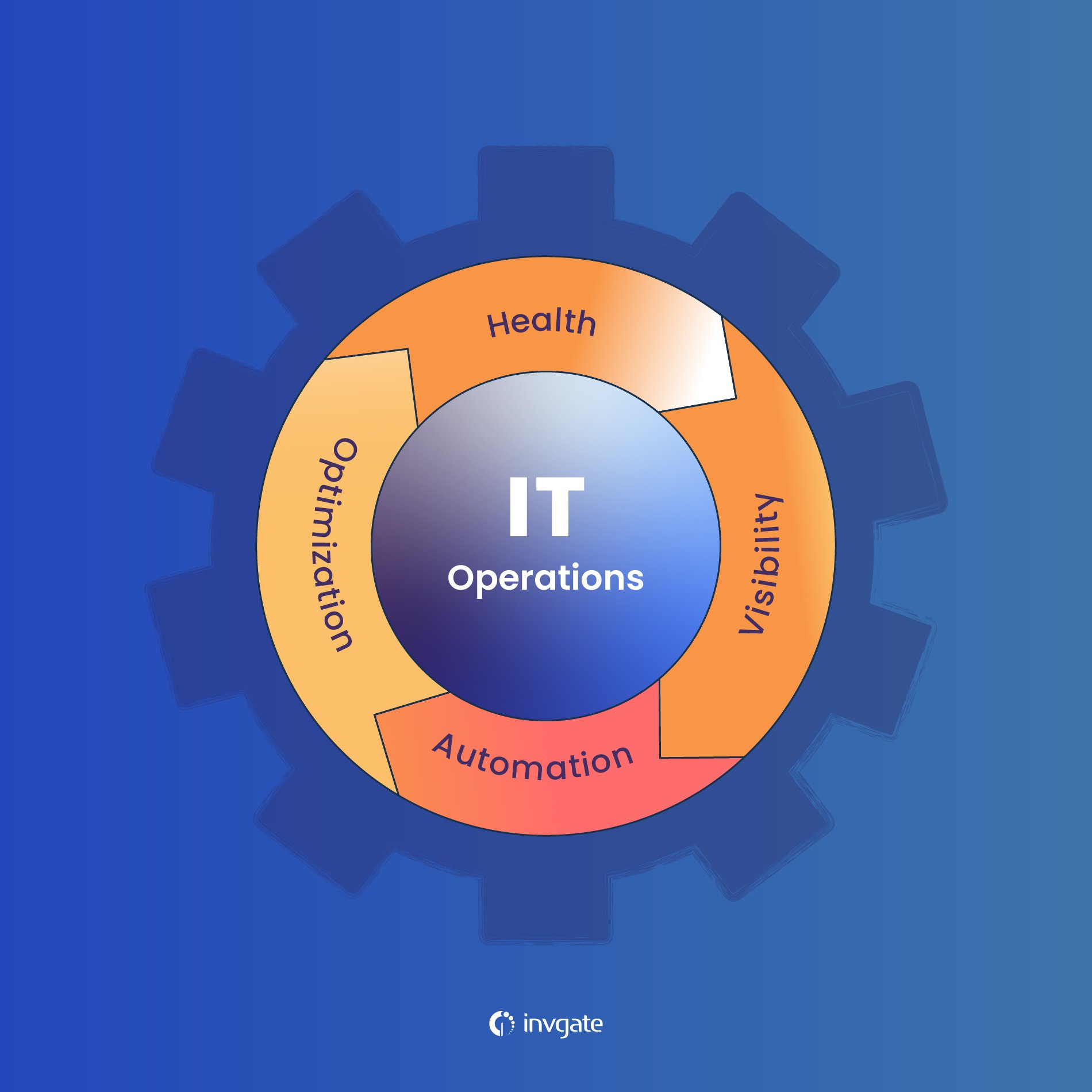
What are some of the main challenges faced by IT operations?
With an ever-evolving tech landscape, ITOps is constantly facing new challenges. Here are some of them.
Low data observability
Due to the huge amount of data produced by the organizations, IT operations personnel are finding it difficult to analyze them and find effective solutions to improve the systems. This is further hampered by data silos splitting the data into disconnected segments in different departments.
Piecing together these distinct segments, forming a complete picture, collecting insights, and implementing the improvements are key challenges for ITOps personnel across organizations. Often important alerts and alarms are missed or often ignored in the never-ending stream of data leading to catastrophic failures.
Organizations and industry experts are coming up with new solutions to overcome this. This includes AI for IT operations, evolving ITOps into AIOps. But we’re yet to see what the future holds for this.
Shift to remote work
The sudden shift to remote work over the pandemic created a huge challenge for IT operations personnel. They were forced to rapidly redesign the IT infrastructure to support employees working away from offices in geographically distributed locations. ITOps had to provide secure access to employees to organizations’ networks and at the same time monitor the same for malicious actors who took this opportunity to launch large-scale cyber attacks.
Organizations also took this as a chance to improve their digital workspaces and introduce new applications for empowering employees. ITOps personnel had to rapidly configure the organization’s IT infrastructure to support the extra bandwidth and provide a seamless remote work experience, all the while working remotely themselves.
Distributed devices with IoT
Organizations have started to adopt the internet of things into their enterprise systems. These devices provide improved visibility into the processes as well as enable widespread automation. For ITOps, this means supporting a new range of devices and sensors deployed all over the organization. And for organizations developing consumer IoT devices, this meant devices that were often used by untrained users in different types of environments.
And these devices were often quite unlike other always-on devices. Some of them had specific sleep patterns and energy-conserving mechanisms. This meant the ITOps personnel had to come up with specific strategies to support these devices, send them updates, keep them secure and functional, all the while malicious actors were trying to target them on large scale.
Aligning business goals with ITOps activities
Finding the right balance between what’s best for IT operations and what’s best for business is a constant challenge. ITOps have to constantly work to get the most out of their resources and deliver the best for the organization.
For example, an organization’s revenue stream may have taken a hit and at the same time, ITOps have to upgrade some expensive hardware. Of course, they can delay the upgrade, but that may prove to be costly. Or maybe the organization has the resources for the upgrade, but doing so presents a risk of an outage that can prove costly.
In these situations, ITOps personnel have to work with the stakeholders to find the right balance.
